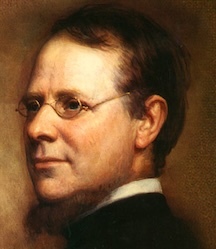Inside a glorious West Side church built with stones salvaged from 19th century city landmarks
When Father Isaac Hecker began planning a new Catholic church on Columbus Avenue and 60th Street, he imagined a “noble basilica” that would reflect “the artistic ideals of the past, with the American genius of his day,” states the website of that church, St. Paul the Apostle.

Born to German immigrant parents in 1819 and raised Methodist, Father Hecker (below) didn’t fit the typical description of a New York Catholic priest. In his youth he worked as a delivery boy at the bakery founded by his older brothers, which soon became the Hecker Flour Company.

After decades of study, travel, and reflection concerning his true purpose in life, he converted to Catholicism and was ordained into the priesthood in 1849.
He went on to found the Paulist Fathers, the first community of Catholic priests in the U.S.—known as an inclusive, evangelizing community that also took on the social issues of the day.
In the 1860s, Father Hecker and the Paulist Fathers had a small church they eventually outgrew on the site where the new church would be built.

Working with architect Jeremiah O’Rourke, Father Hecker shared his vision of a monumental edifice inspired by the 4th and 5th century Christian basilicas in Ravenna, Italy. He also drew inspiration from 13th century Gothic cathedrals in France and England.
The cornerstone was laid in 1876, just as the Ninth Avenue Elevated spurred a population boom in this developing West Side neighborhood (above).
Nine years later, the new Church of St. Paul the Apostle officially opened—but this rough and austere “spiritual fortress,” as one newspaper put it, was far from complete.

As the sanctuary filled with parishioners each week, Father Hecker—who would pass away from leukemia in 1888—put his visionary plans for the interior in place.
He called upon John LaFarge to craft beautiful stained-glass windows, Frederick MacMonnies to create gilded bronzes of angels, and Stanford White to design the gold and onyx high alter. All three artists finished their work by the close of the century.

Meanwhile, the exterior of St. Paul’s was also getting its finishing touches. For this, Father Hecker and his architectural overseers turned not to artistic geniuses but to salvage.
Though recycled materials from demolished structures likely helped lower costs, “the idea of transforming materials with prosaic origins into ones with a divine purpose parallels the congregation’s reputation for attracting converts to Catholicism,” states the 2013 Landmarks Preservation Commission (LPC) report.

Where did the salvage come from? The Croton Aqueduct was one source—specifically from a dismantled part of a stone embankment that once carried Croton water from Harlem through an Upper West Side area called Clendening Valley to the receiving reservoir in Central Park.
Father Hecker and his architectural team actually acquired the Croton stonework in the mid-1870s and used the small, rough-cut pieces in a staggering pattern in the facade.

In 1899, the distributing reservoir at 42nd Street and Fifth Avenue was decommissioned. St. Paul’s took stones from the demolished reservoir and used them to add several feet to the church’s two front towers, per the LPC Report.
Perhaps the most unusual example of architectural recycling was the salvaging of stone from a fabled Eighth Avenue and 23rd Street theater to build the staircases at the front of the church facing Columbus Avenue.

Booth’s Theater (at right), a grand and flamboyant palace constructed by actor Edwin Booth in 1869, closed its doors in 1883; the hulking structure was to be converted into a department store.

“As part of the renovation, some of the theater’s stonework was apparently removed by the contractor and sold to the church,” states the LPC report.
Like most churches, St. Paul the Apostle has open hours when visitors can wander through.
Take a walk through this art museum of a church, and as you gaze at the facade and ascend the staircases, know that you’re experiencing remnants of 19th century Gotham that could have easily been destroyed rather than recycled into the modern cityscape.

As for Father Hecker, he’s currently a candidate for canonization.
[Second image: Busted Halo; third image: Church of St. Paul the Apostle; fourth image: LOC]



